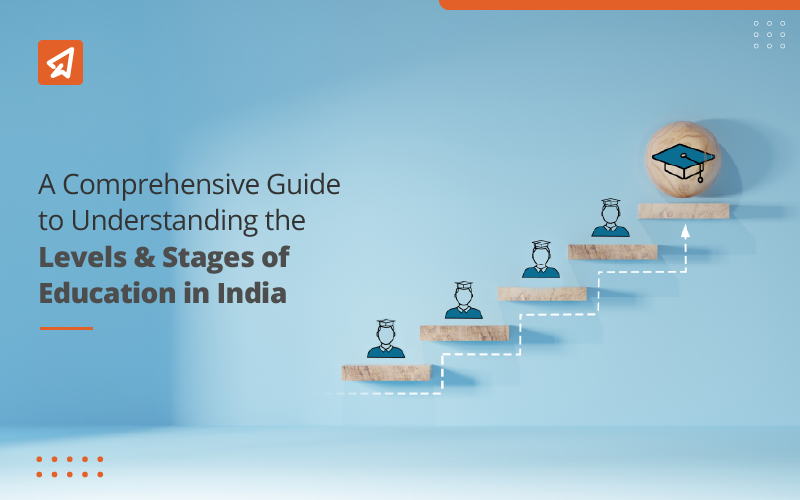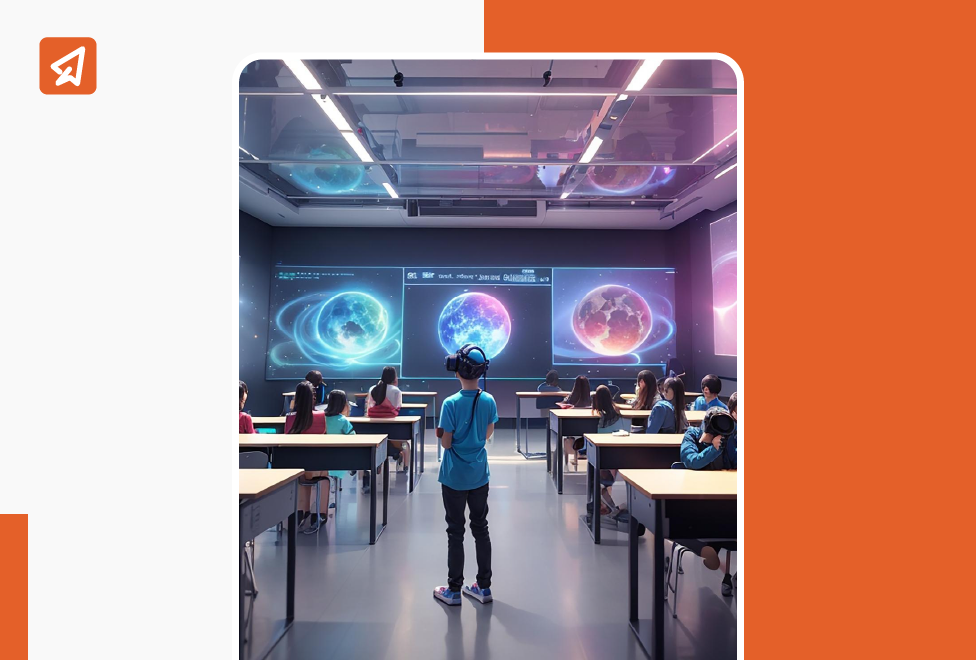Levels of Education in India Today

From the sacred halls of ancient Gurukuls to the bustling corridors of modern K-12 schools, India’s educational landscape has evolved over centuries, embracing change while cherishing tradition. Understanding this intricate system is essential for navigating the labyrinth of educational opportunities it presents.
Whether you are a student, educator, policymaker, or simply an enthusiast eager to delve into the fabric of Indian academia, this guide serves as your companion as you navigate the intricate tapestry of India’s educational system. It unlocks doors to knowledge and fosters a deeper understanding of its profound significance in shaping the nation’s future.
Levels of Education in India:
Pre-Primary Education:
Early childhood education or pre-primary education in India is set between 3-6 years of age. With the main objective of preparing children for primary schooling, these schools are referred to as Play Schools, Play Groups, or Kindergarten. Children learn the basics of communication, behavior, and object identification through activities and play. Even though the entry age for pre-primary is set at 3 years, some parents find it better to send their children in as early as 2 years. Since pre-primary classes are a preparatory phase, they are not part of compulsory schooling years of 10+2 or a predefined curriculum. Levels include Play Group, Nursery, Lower Kindergarten (LKG), and Upper Kindergarten (UKG).
- Common name – Pre-Primary or Play School
- Age of attending – 3 years to 5 years
- Years in this level – 2 to 3 years
- Compulsory – No
- Objective – Preparation for formal education
Primary Education:
The first stage of formal schooling, also called primary classes, starts after the age of 6 years, going up to 11 years. Offered by both government and private schools, this stage covers classes 1 to 5 in some states and classes 1 to 4 in others. The focus of this stage is to introduce children to basic concepts of key subjects such as mathematics, science, geography, regional language, etc. Primary school classes in India, offered free of cost by government schools are also part of compulsory elementary education mandated by the government for children between the ages of 6 to 14.
- Common name – Primary School or Elementary Education
- Age of attending – 6 to 11 years
- Years in this level – 5 to 6 years
- Compulsory – Yes
- Objective – Introduction to basics of key subjects
- States/UTs that follow 1st to 5th class of primary education – Delhi, Andhra Pradesh, Haryana, Jammu & Kashmir, Bihar, Karaikal and Yanam regions of Pondicherry Madhya Pradesh, Arunachal Pradesh, Manipur, Orissa, Himachal Pradesh, Punjab, Chandigarh, etc.
- States/UTs that follow 1st to 4th class of primary education – Dadra & Nagar Haveli, Maharashtra, Assam, Karnataka, Goa, Kerala, Meghalaya, Gujarat, Mizoram, Daman & Diu, Nagaland, Mahe region of Pondicherry, Lakshadweep, etc.
The Middle School:
Also known as high school or senior school, the middle school covers classes between 5th or 6th up to 8th with students between the ages of 12 to 14 years. The objective of education at this stage is to teach more advanced topics within the main subjects covered at the primary education level, reflecting the diverse schooling levels in India.
- Common name – High School, Senior School or Middle School
- Age of attending – 12 to 14 years
- Years in this level – 2 years
- Compulsory – Yes
- Objective – Advance or more complex aspects of the main subjects
- States/UTs that offer 5th – 7th class of middle stage – Goa, Assam, Kerala, Gujarat, Dadra & Nagar Haveli, Karnataka, Daman & Diu, Lakshadweep, etc.
- States/UTs that offer 6th – 8th class of middle stage – Delhi, Haryana, Arunachal Pradesh, Punjab, Madhya Pradesh, Chandigarh, Andaman & Nicobar Islands, etc.
The Secondary School:
This stage of education covers classes 9th and 10th with students aged between 14 and 16. Schools that offer education up to this stage are called Secondary schools. They are also referred to as high schools or senior schools, similar to the nomenclature of middle schools seen at the previous level. At the end of this stage, students appear for board exams that test for student knowledge and skill formally. These exams are conducted by the educational boards outside the purview of the school the students are enrolled at. The above 3 stages of formal education in India (Primary, Middle and Secondary) constitute the 10 years of the 10+2 model.
- Common name – Secondary School, High School or Senior School
- Age of attending – 14 to 16 years
- Years in this level – 2 years
- Compulsory – Not as per the government, however, mandatory in perusal of higher education
- Objective – Advanced and detailed concept of key subjects
- States/UTs that follow the 8th – 10th class of the secondary stage – Kerala, Goa, Karnataka, Gujarat, Dadra & Nagar Haveli, Lakshadweep, Daman & Diu, etc.
- States/UTs that follow the 9th – 10th class of secondary stage – Delhi, Rajasthan, Punjab, Sikkim, Andaman & Nicobar Islands, Tamil Nadu, Chandigarh, Karaikal region of Pondicherry etc.
Senior Secondary Stage:
This is the subsequent +2 level of the 10+2 model. The senior secondary stage is a 2-year educational stage followed uniformly across the country. Covering classes 11th and 12th, the senior secondary has students aged between 16 and 18 years of age. At the beginning of this stage, students are given a choice to pick their subjects of interest and pursue those for two years. At the end of the 12th class, students again appear for board exams conducted outside the school purview by the educational boards to gauge their knowledge and skill in the chosen subjects. Schools that offer education at this level are referred to as Senior Secondary Schools or Higher Secondary Schools. In a few states like Maharashtra, this stage is also offered by colleges or universities and is referred to as Junior College.
- Common name – Senior Secondary School, Higher Secondary School or Junior College
- Age of attending – 16 to 18 years
- Years in this level – 2 years
- Compulsory – Not as per the government, however, mandatory in perusal of higher education
- Objective – Advanced and detailed knowledge of chosen subjects
Undergraduate Stage:
The undergraduate stage, popularly known as graduation or bachelor’s degree in India, is 3 to 4 years long, with the 3-year courses predominantly in the fields of arts, humanities, science, and commerce. Degree courses in engineering, agriculture, pharmaceuticals, etc., adopt a 4-year curriculum, while those in the fields of law, medicine, architecture, etc., take 5 years for a bachelor’s degree. Students usually begin this stage right after finishing the senior secondary level at the age of 18 years. Admissions into colleges, universities, or specialised institutions for this stage are granted either based on performance in the senior secondary board-level examination or through specifically conducted entrance exams. Almost 90% of colleges in India offer courses at this level.
- Common name – Undergraduate degree, Bachelor’s Degree or Graduation
- Age of attending – 18 to 23 years
- Years in this level – 3 to 5 years
- Compulsory – Not as per the government, however, mandatory in perusal of higher education
- Objective – Subject specialisation and in-depth knowledge of specific fields
Postgraduate Stage:
Postgraduate education, also referred to as higher education, is largely offered by universities. Spanning 2 to 3 years, courses at this stage are also referred to as Master’s or Doctorate, depending on the depth of work. Masters studies are usually covered over 2 years, while doctorate research and studies take at least 3 years. This stage is largely concerned with advancing knowledge, researching newer aspects and producing original work in specific fields and sub-topics of preferred disciplines. Education at this level goes into specialisations, and only those who are interested in pursuing academics or working with large research take on these courses.
- Common name – Postgraduate Degree, Master’s Degree or Doctorate.
- Age of attending – 21 to 25 years
- Years in this level – 2 to 3 years
- Compulsory – No
- Objective – Sub-topic research within a subject specialisation and subject matter expertise
Educational Access Without Institutions
The education policy of India also provides for those who want to pursue education outside of formal institutes for different reasons. Through Distance learning and education, controlled by the Distance Education Council of India, those unable to join regular schools and colleges can also complete their education. The National Institute of Open Schooling also makes distance learning possible for students unable to devote time to regular classes – such as children pursuing sports, children of parents with transferable jobs or those with special needs or disabilities.
Homeschooling is slowly gaining traction. It is considered an alternative education method, and parents have the option to choose from different approaches such as the Montessori Method, Waldorf Education, Radical Unschooling or School-at-home. Standard school boards, such as CBSE, IGCSE, NIOS, etc., also provide a prescribed syllabus that parents can follow.
With easy internet access, digital resources and the emergence of smart edtech whichever approach of education – Formal or outside of institutions – you and your child decide upon, finding the right support system can be just a click away. Online learning apps like Extramarks are equipped to support not just school administration and teachers but also the students and their parents. With offerings such as Smart School Solutions, it can assist all stakeholders and ensure seamless and quality education for every child.
FAQs
At what age do children start formal education in India?
As per the Indian education policy formal education in India starts at the age of 6 with Primary education, however preparation for the primary level starts at the pre-primary stage. Depending on the state and educational institute, children begin education between the ages of 3 to 6 years.
-
What is the difference between secondary and higher secondary education in India?
Secondary education in India starts around age 14, going up to 16 years from class 8 to 10. During this stage, complex topics within given subjects are taught to the students. On passing 10th, students enter the higher secondary stage of education. During classes 11 and 12, students have the freedom to choose their subjects as per their interests and previously displayed knowledge.
Last Updated on November 11, 2024
Reviewed by

Priya Kapoor | AVP - Academics
Priya Kapoor is an accomplished education professional with over 18 years of experience across diverse fields, including eLearning, digital and print publishing, instructional design, and content strategy. As the AVP – Academics at Extramarks, she leads academic teams in creating tailored educational solutions, ensuring alignment with varied curricula across national and international platforms...read more.









